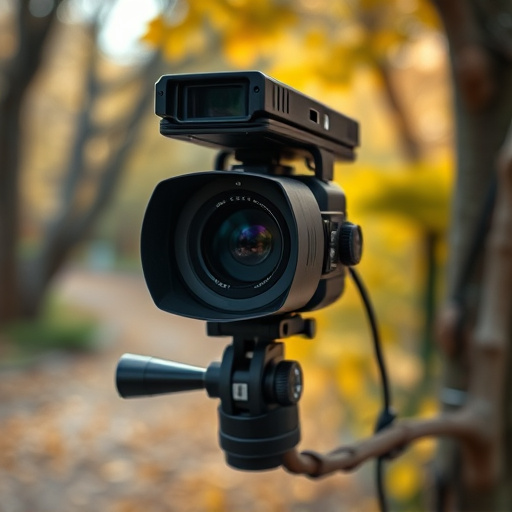Radio Frequency (RF) detection is a powerful tool for renters considering discrete security cameras, which operate on RF signals. To maximize efficiency, prepare your space by turning off interfering electronics and removing metal objects. Use an RF detector to scan potential hiding spots, cross-referencing data with known signals to identify anomalies. Regular maintenance includes updating software, understanding local laws, and keeping detailed records of sweep results.
Discover the power of RF (Radio Frequency) detection in identifying hidden cameras, a crucial skill for renters seeking discrete security solutions. This tutorial guides you through every step, from understanding RF technology’s role in camera detection to preparing your space and conducting a thorough sweep. Learn how to interpret results and maintain your system effectively. With these tips, renters can ensure their privacy and peace of mind by detecting and neutralizing hidden cameras discreetly and efficiently.
- Understanding RF Detection and Its Role in Camera Detection
- Preparing Your Space for a Discrete Security Camera Sweep
- Step-by-Step Guide: Detecting Hidden Cameras Using RF Technology
- Post-Sweep Analysis and Maintenance Tips for Renters
Understanding RF Detection and Its Role in Camera Detection
Radio Frequency (RF) detection is a crucial method in identifying and detecting hidden cameras, especially for renters considering discrete security cameras. RF signals are omnipresent in our modern world, from wireless routers to remote controls. Hidden cameras often transmit data using these RF waves, making them a valuable target for detection. The role of RF detection in camera detection is twofold: it helps identify active cameras and can pinpoint their location within a premises.
For renters looking to maintain privacy, understanding RF detection offers a proactive approach to securing spaces. By employing tools that can sweep through various RF frequencies, individuals can ensure that no covert recording devices are operating without their knowledge. This practice is particularly relevant when renting, as it empowers tenants to take control of their personal safety and data privacy.
Preparing Your Space for a Discrete Security Camera Sweep
Before conducting an RF detector sweep for hidden cameras, it’s crucial to prepare your space. Since Discrete Security Cameras for Renters are often used in residential or shared spaces, discretion is key. Turn off all electronics and appliances that could interfere with the signal of your RF detector, such as Wi-Fi routers, microwaves, and baby monitors. Empty rooms of any metal objects, like furniture legs or decor items, as these can cause false readings. Ensure every corner and nook is accessible so you can thoroughly sweep the entire area without obstructions.
Organize your equipment in advance: place your RF detector, a notepad for notes, and any other necessary tools within easy reach. Choose a quiet time when the space will be free from unexpected visitors or disruptions to conduct the sweep. This preparation will ensure a smooth process, allowing you to focus on detecting potential hidden cameras with maximum efficiency.
Step-by-Step Guide: Detecting Hidden Cameras Using RF Technology
Step-by-Step Guide: Detecting Hidden Cameras Using RF Technology
The first step in detecting hidden cameras using radio frequency (RF) technology is to understand that many discrete security cameras for renters operate on RF signals. These devices often emit unique frequencies, making them detectable with the right equipment. Start by acquiring an RF detector, a handheld device designed to sniff out these signals. Ensure your detector is capable of scanning across a broad range of frequencies – from 2.4 GHz to 5.8 GHz – as hidden cameras can operate within these bands.
Next, power down any electronic devices that might interfere with the scan, including Wi-Fi routers and microwaves. Then, hold the RF detector close to walls, furniture, or any potential hiding spots where a hidden camera might be installed. As you move the detector, it will indicate when it detects an RF signal. If a continuous beep or solid light indicates a steady signal, it could suggest the presence of a hidden camera. Further investigation using visual or infrared aids is necessary to confirm and locate the device.
Post-Sweep Analysis and Maintenance Tips for Renters
After conducting an RF detector sweep, renters should dedicate time to post-sweep analysis and maintenance. This involves reviewing the data collected during the scan, cross-referencing it with known signals from common devices to identify any anomalies. Discreet security cameras for renters often operate on specific frequencies, so recognizing these on the sweep results is crucial. Any unusual readings could indicate hidden cameras, requiring further investigation using specialized equipment or seeking expert assistance.
Regular maintenance includes updating software and firmware for both detection tools and any identified security devices to ensure optimal performance. Renters should also educate themselves about local privacy laws related to surveillance to avoid legal pitfalls. Additionally, keeping detailed records of sweep results and any actions taken can help in the future if a re-scan is necessary, ensuring continuous protection with discrete security cameras for renters.
Detecting hidden cameras using RF technology is a valuable skill, especially for renters concerned about their privacy. By understanding RF detection and following the step-by-step guide provided, you can ensure a thorough sweep of your space. This article has equipped you with the knowledge to navigate the process discreetly and effectively, empowering you to maintain your security and peace of mind. For renters, staying informed about potential hidden cameras is an essential step in safeguarding your personal spaces.
